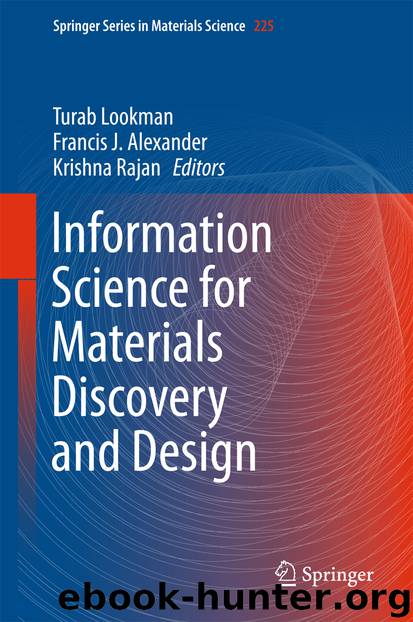Information Science for Materials Discovery and Design by Turab Lookman Francis J. Alexander & Krishna Rajan

Author:Turab Lookman, Francis J. Alexander & Krishna Rajan
Language: eng
Format: epub
Publisher: Springer International Publishing, Cham
7.3.2 Using Simple Experiments to Evaluate Simulation Results
We next considered some simple single-track experiments [20] to evaluate the findings from our simulations. In these experiments, a single layer of powder is spread on a plate and a single track created at a specific laser power and speed. The powder is then removed, and the plate cut so that the cross-section of the track can be obtained and the melt-pool characteristics measured.
Based on prior work, we had decided to use a powder layer thickness of 30 as this had resulted in the highest density in experiments with 316L powder [21]. The layer thickness is the amount by which the build platform is lowered in each layer of the build. Since the powder is porous, its height decreases when it melts. Therefore, the next layer of powder has a depth greater than the set value of layer thickness. Due to the shrinkage on melting, the initial layers of powder are progressively deeper, until the thickness of the powder reaches a steady state that is determined by the amount of shrinkage of the powder on melting.
When we translate the results of the E-T model to single-track experiments , we need to account for the fact that the simulations are just an approximation and there is no powder considered in the model. So the melt-pool depth from the E-T model should be sufficiently large compared with the thickness of the powder in the experiment to ensure that the substrate melts as well. We therefore focused on the simulations that gave a melt-pool depth of two to three-times the set layer thickness. Note that this factor is just an approximation that helps us to constrain the range of parameters. In addition to avoiding process parameters that resulted in relatively shallow melt pools, we also wanted to avoid those that gave very deep melt pools. Not only would this have been wasteful, but a high energy density would have resulted in the process going from conduction-mode melting to keyhole-mode melting, resulting in voids that would have introduced porosity into the part [12].
Using the results from the E-T simulations, we identified fourteen power and speed combinations that we used to create tracks on a tilted plate as shown in Fig. 7.4. This build plate has a tilt so that the layer thickness is 0 at the left and 200 at the right, enabling us to evaluate the effect of the process parameters at different layer thicknesses.
Fig. 7.4The tilted build plate with the 14 tracks, each generated using a different value of laser power and scan speed, as listed in Table 7.3, where track 1 corresponds to the track at the top of the plate. The layer thickness is near zero at the left edge of the plate, increasing linearly to 200 at the right edge. The plate is cut vertically to analyze the melt-pool cross-section at a specific layer thickness
Download
This site does not store any files on its server. We only index and link to content provided by other sites. Please contact the content providers to delete copyright contents if any and email us, we'll remove relevant links or contents immediately.
Algorithms of the Intelligent Web by Haralambos Marmanis;Dmitry Babenko(8522)
Building Statistical Models in Python by Huy Hoang Nguyen & Paul N Adams & Stuart J Miller(7367)
Azure Data and AI Architect Handbook by Olivier Mertens & Breght Van Baelen(7365)
Serverless Machine Learning with Amazon Redshift ML by Debu Panda & Phil Bates & Bhanu Pittampally & Sumeet Joshi(7252)
Data Wrangling on AWS by Navnit Shukla | Sankar M | Sam Palani(7018)
Driving Data Quality with Data Contracts by Andrew Jones(7006)
Machine Learning Model Serving Patterns and Best Practices by Md Johirul Islam(6736)
Learning SQL by Alan Beaulieu(6158)
Weapons of Math Destruction by Cathy O'Neil(6084)
Big Data Analysis with Python by Ivan Marin(5730)
Data Engineering with dbt by Roberto Zagni(4728)
Solidity Programming Essentials by Ritesh Modi(4394)
Time Series Analysis with Python Cookbook by Tarek A. Atwan(4224)
Pandas Cookbook by Theodore Petrou(3940)
Blockchain Basics by Daniel Drescher(3429)
Hands-On Machine Learning for Algorithmic Trading by Stefan Jansen(2965)
Natural Language Processing with Java Cookbook by Richard M. Reese(2958)
Feature Store for Machine Learning by Jayanth Kumar M J(2863)
Learn T-SQL Querying by Pam Lahoud & Pedro Lopes(2850)
